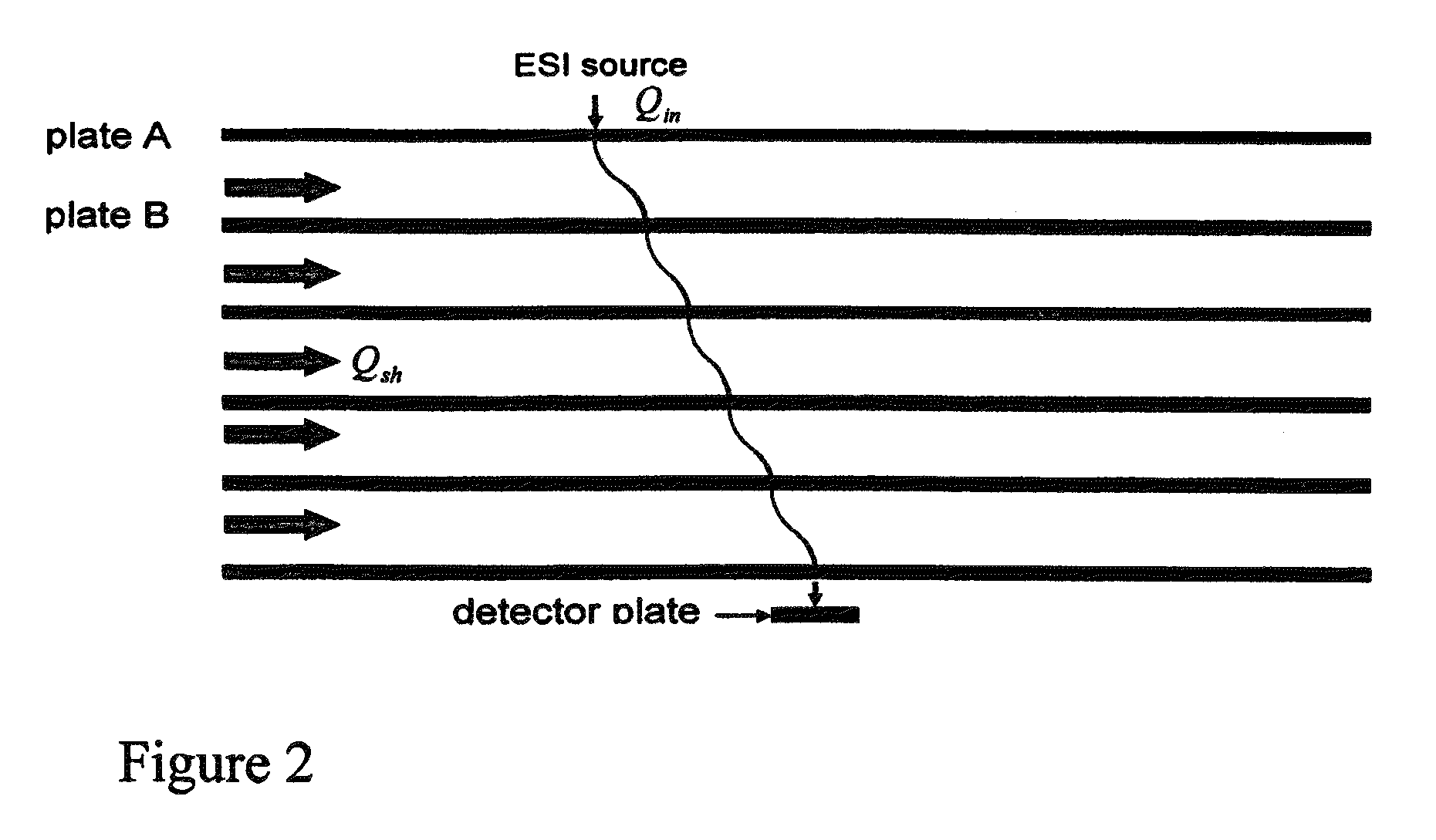Periodic field differential mobility analyzer
a technology of differential mobility and analyzer, which is applied in the field of ion mobility spectrometry and ion analysis, can solve the problems of limiting the resolution of prior art dmas, unreliable type of instruments, and inability to select particles/ions according to their mobility, so as to increase the amount of electrical work and increase the resolution
- Summary
- Abstract
- Description
- Claims
- Application Information
AI Technical Summary
Benefits of technology
Problems solved by technology
Method used
Image
Examples
example 1
[0083]A prototype PFDMA consisting of a pair of four 0.50 mm channels separated by 0.50 mm was constructed. The arrangement was similar to the schematic shown in FIG. 3, i.e. in an inline mode. The gas flow was produced using a common vacuum cleaner connected to a rheostat to set the velocity, drawn in from the surrounding laboratory air (unfiltered). The ion source consisted of a thin tungsten wire biased to 2 kV relative to two tungsten wire counter electrodes. Detection of ions was made by a sensitive current to voltage converter. Spectra were acquired by manually stepping the total voltage and recording the average ion current at each voltage step.
[0084]Referring now to FIG. 10a, a spectrum of voltage versus ion intensity (inverse ion mobility versus ion intensity) is shown for background air ions in negative mode. One peak is present in the spectrum, most probably O− or O2− or a small reactant product of these species; because the mobility is high (a low voltage is required to ...
example 2
[0089]A prototype PFDMA comprising a pair of six 0.50 mm channels separated by 0.50 mm was constructed. The arrangement was similar to the schematic shown in FIG. 3, i.e. in an inline mode. The gas flow was produced using a common vacuum cleaner connected to a rheostat to set the velocity, drawn in from the surrounding unfiltered laboratory air. The ion source consisted of a thin tungsten wire biased to 2 kV relative to two tungsten wire counter electrodes. Detection of ions was made by a sensitive current to voltage converter. Spectra were acquired by using a computer to simultaneously step the voltages of individual programmable high voltage power supplies connected to each electrode and recording the average ion current at each voltage step using an ADC board.
[0090]Referring now to FIG. 12a, an overlay spectrum of voltage versus ion intensity (inverse ion mobility versus ion intensity) is shown for background air ions (most probably clusters ions of H2O) and product ions of aceto...
PUM
| Property | Measurement | Unit |
|---|---|---|
| voltage drop | aaaaa | aaaaa |
| flow rate | aaaaa | aaaaa |
| inlet flow rates | aaaaa | aaaaa |
Abstract
Description
Claims
Application Information
 Login to View More
Login to View More - R&D
- Intellectual Property
- Life Sciences
- Materials
- Tech Scout
- Unparalleled Data Quality
- Higher Quality Content
- 60% Fewer Hallucinations
Browse by: Latest US Patents, China's latest patents, Technical Efficacy Thesaurus, Application Domain, Technology Topic, Popular Technical Reports.
© 2025 PatSnap. All rights reserved.Legal|Privacy policy|Modern Slavery Act Transparency Statement|Sitemap|About US| Contact US: help@patsnap.com



